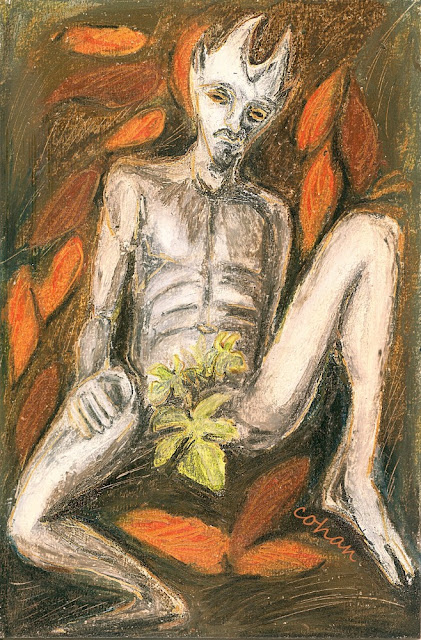Note: Some of these images will suggest 'devils' or 'demons' to some viewers, coming from a Christian perspective. That is not what they are: these are based on images and concepts from European cultures long before Christianity was born. With the coming of Christianity, which was often introduced from the top down (i.e. rulers converted first) and by law rather than heart, many aspects of the old nature based religions were vilified, even outlawed, as part of the effort to convert populations, and to enforce orthodoxy. So, the old gods became demons, devils, witches, temptresses etc.
Recently I dug up/edited some scans of old drawings - 2006 (last ones maybe 2007?) for this set- based on images/thoughts in Marija Gimbutas' archaeological writing/drawings/photographs/theories about ancient European Goddess culture (predating the Indo-European gods/goddesses we are more familiar with). Some of her conclusions may seem over-confident to some , but I still find the underlying ideas and images appealing! These are mixed media on paper- coloured pencils, oil pastels etc, some with watercolour. Some are very close to the originals, others more exploratory on my part. I've returned to these themes many times, some drawings no more than sketches, others more developed. After having lost many images from my hard drive late last year, I have many to re-scan, these are just a few that were saved.
Bird Goddess- believed by Gimbutas to be one of the oldest goddesses, associated with earth/water/sky and therefor birth/ life/death. Bird Goddess as a sort of primal/Mother deity has been my favourite, and I've returned to her repeatedly, retaining some of the ancient themes, and developing some of my own bits of the iconography. Emphasis of breasts and pubic triangle on ancient images suggest an important role in fertility cults; the addition of a sprouting seed as navel strengthens the ties to birth/growth not only of humans, but all of the natural and cultivated world.
Water Goddess -these are based on ancient vessels, the mouth was likely a spout (if I remember correctly, can't find the book just now...) I feel these may rather resemble funerary masks, but I don't think that was the intention of the originals- the eyes and mouth may seem to be voids because they were openings in the vessel, or perhaps something was placed into the eye holes..
Horned Gods- I don't think these drawings had any direct inspiration in Gimbutas' work. Horned Gods were numerous, with various meanings across time/space. Originally there were likely woodland spirits with antlers, and these remained in many places. Goats, rams, bulls, cows presumably came later with the transition to herding/farming. Popular motifs deal with protection of field and forest and the animals in both, as well as ideas of harvest (including grapes/wine). Of course they were all demonised/ called devils, later by a Christian Church bent on conversion/compliance.
We may never know the details of ancient worship, certainly lack clear evidence now. What is clear is that the Old Ways did not simply disappear. First came the waves of Indo-European cultures- whether this was more invasion or integration is not certain, likely enough some of both. The pantheons of these people (ancestors of Hellenic, Italic, Slavic, Baltic, Nordic etc) with their numerous gods and goddesses of earth and sky generally (nominally?) replaced the more ancient animistic Goddess culture (presumed? purported? imagined? we are gleaning from echoes, extrapolating from scattered leavings!). Nonetheless, it seems the Older Gods in many cases became mixed/muddled with the Indo European pantheon that came after- many of those gods bearing clear links/overlaps to more ancient cults. This mixing or renaming continued into Christian times, with saints often assuming the characteristics of ancient gods/goddesses, and the Church often planting its holy days (and buildings!) squarely on top of existing dates and sites of veneration.
While religious officials may long for religious purity, common folk have been less troubled by combining seemingly incongruous practises and beliefs. Even now (especially now?) in modern secularised societies, many observe Church holidays while comfortably-even simultaneously- carrying on seasonal and domestic observances, many of which have pre-Christian roots and even pre-Indo-European.
So, from my own personal, light hearted yet deeply reverent syncretism: Bird Goddess says: "Be kind, you are one with all that is."
Comments on the ease of reading on this platform are welcome. I'm also starting to experiment with Wordpress. You can find me on
If you are able and would like to support me, I have a Ko-fi page; support helps me keep working-more research, more writing, more art!
(see this post for musings on support sites: https://cohanmagazine.blogspot.com/2021/01/fiction-feedback-and-finances.html ).










Love this article, Bird Goddess is one of my favourite themes and inspiration
ReplyDeleteThanks, great to hear that! (this is Cohan, it's not letting me sign in for comment right now..lol)
ReplyDeleteThis was a interesting read for sure love it, amazing work 👍🏽
ReplyDelete
DeleteThanks, glad you enjoyed it! Always more to learn :)